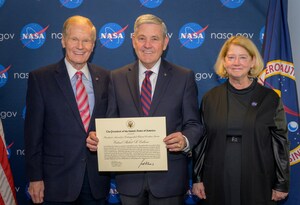HOUSTON, Nov. 2, 2017 /PRNewswire-USNewswire/ -- Two astronauts with eight space shuttle missions between them have retired from NASA. Both Nancy Currie-Gregg and Steven L. Smith left the agency after careers that began even before they became astronauts.
"Nancy and Steve each brought so much to NASA during the course of their careers," said Pat Forrester, chief of the Astronaut Office at NASA's Johnson Space Center. "They made great contributions not just to the astronaut office and the Johnson Space Center but to the entire agency. We appreciate their service over the past several decades and wish them well in the future."
Currie-Gregg first came to NASA as a flight simulation engineer in 1987. She was selected as an astronaut in 1990, completed her astronaut candidate training in 1991 and flew on her first mission in 1993. As a mission specialist on space shuttle Endeavour's STS-57 mission that year, she helped retrieve the European Retrievable Carrier satellite and conducted experiments inside the pressurized laboratory SPACEHAB on its first flight.
She returned to space onboard space shuttle Discovery in 1995 for STS-70 and helped to deploy a Tracking and Data Relay Satellite. In 1998, she was part of the first assembly mission for the International Space Station, during Endeavour's STS-88 mission. And she visited the Hubble Space Telescope in 2002 as part of space shuttle Columbia's servicing mission, STS-109. In all, she spent 1,000 hours in space.
Her work for NASA did not end there, however. Following the space shuttle Columbia accident in 2003, Currie-Gregg was selected to lead the Space Shuttle Program's Safety and Mission Assurance Office. She also served as manager of the Habitability and Human Factors Office; senior technical advisor in the Automation, Robotics and Simulation Division; deputy director of Johnson's Engineering Directorate; and chief engineer for NASA's Engineering and Safety Center. At the time of her retirement, she was principal engineer for NASA's Engineering and Safety Center.
Currie-Gregg was born in Wilmington, Delaware, but considers Troy, Ohio, to be her hometown. She earned a bachelor's degree in biological science from The Ohio State University; a master's in safety engineering from the University of Southern California; and a doctorate in industrial engineering from the University of Houston. She achieved the rank of colonel in the U.S. Army before retiring in 2005 and has logged more than 4,000 hours of flight time in a variety of rotary-wing and fixed-wing aircraft.
Smith was selected as an astronaut in 1992, after first coming to NASA in 1989 as a payload officer in the Mission Operations Directorate. He was the first member of the 1992 class to receive a flight assignment and made his first of four spaceflights in 1994 as part of Endeavour's STS-68 mission, conducting Earth observations with the Space Radar Laboratory.
Smith flew again aboard Discovery in 1997, as part of the STS-82 crew, visiting the Hubble Space Telescope and performing three of the mission's four spacewalks. He returned to Hubble and served as the payload commander in 1999 as part of the STS-103 mission, again onboard Discovery, and performed two more spacewalks.
Smith's final flight came in 2002, on board space shuttle Atlantis for STS-110. Visiting the new International Space Station, he served as the lead spacewalker, performing two more spacewalks and helping to install the station's initial truss segment.
During those four missions, Smith conducted seven spacewalks, totaling 49 hours and 25 minutes. He currently ranks seventh on the list of most time spent spacewalking by U.S. astronauts.
Following his final spaceflight, Smith continued to serve in a variety of positions at NASA, such as the Automated Transfer Vehicle (ATV) Launch Package Manager for all five ATV flights, the International Space Station Program's liaison to the European Space Agency, and associate director for the program's science directorate at NASA's Ames Research Center in California.
Smith was born in Phoenix, Arizona, and considers San Jose, California, his hometown. He earned a bachelor's degree in electrical engineering, and two master's degrees in electrical engineering and business administration, all from Stanford University.
Currie-Gregg's complete biography is available at:
https://www.nasa.gov/sites/default/files/atoms/files/currie.pdf
Smith's complete biography is available at:
https://www.nasa.gov/sites/default/files/atoms/files/smith-s.pdf
SOURCE NASA
Related Links
WANT YOUR COMPANY'S NEWS FEATURED ON PRNEWSWIRE.COM?
Newsrooms &
Influencers
Digital Media
Outlets
Journalists
Opted In





Share this article